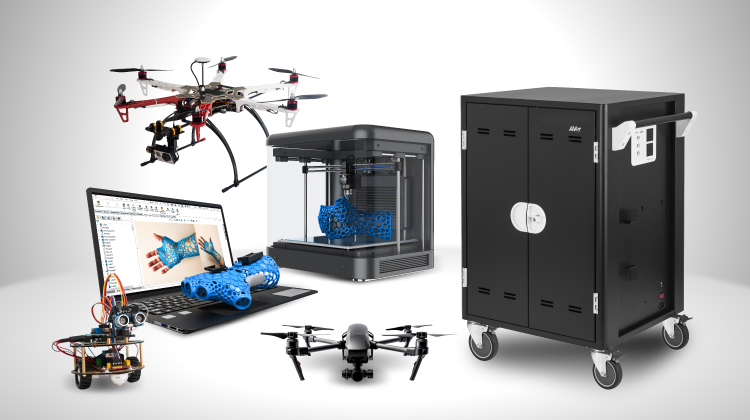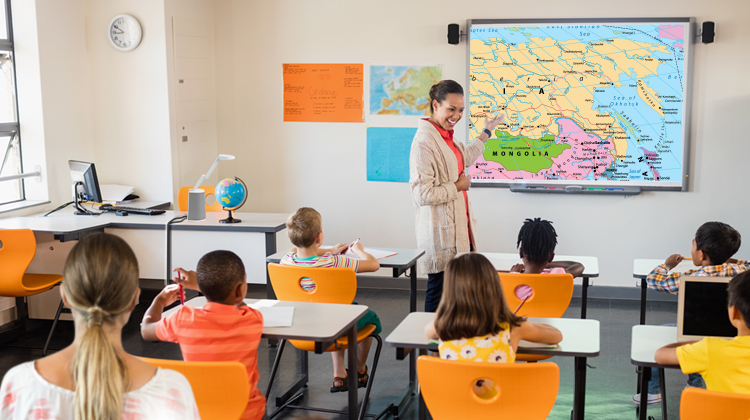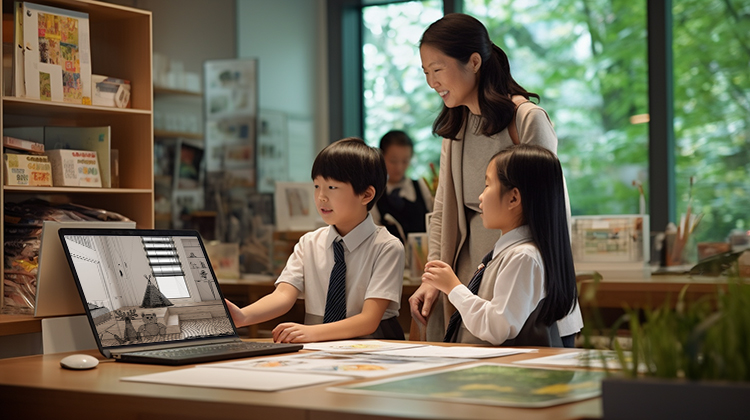The world is changing in large part due to the technological advances in recent years. With everything interconnected through the internet, AR and VR technologies creating immersive AV experiences, and now generative AI breakthroughs, it seems that students nowadays have a lot on their plates. With adults scrambling to learn new skill sets amidst these large-scale transformations, the question that plagues the minds of countless teachers all over the world is: how can educators give future generations the skills required to thrive in an ever-changing future world?
We had the honor of interviewing Superintendent Haishuo Lee of Wagor International School, a leader in Taiwanese education from K-12 located in Taichung central Taiwan. He shares his thoughts on the challenges of pushing education technology and the core competencies in the era of generative AI.
Technology Utilization at Wagor International School
Q: How does Wagor International School utilize technology in schools?

I’d like to start by saying Wagor International School is a rather special school, as it holds the title of the very first Apple Distinguished School in Taiwan. Wagor has been purchasing iPads for every single student from middle to high school for around a decade, ensuring every student always has a powerful learning tool. We give the students the iPad, meaning that the iPads are now the students’ property.
Now, you must be wondering why we are so generous with giving out iPads. There are two main reasons. Firstly, students pay close attention to taking good care of their iPads, rather than viewing them as school property that they don’t particularly care for. Second, when a student owns an iPad, they spend more time getting acquainted with the device, which nurtures their learning habits. If students only spend a bit of time during certain classes using iPads, then they are less familiar with the device and are less capable of using the iPad as an incredible learning tool.
When teaching younger students in kindergarten to elementary school, we don’t give out iPads like we do for middle and high school students due to parental concern over digital screen time. Still, we make sure that students have access to iPads in class and we do so by utilizing charging carts from AVer, which we believe to be the most reliable brand for this product. At Wagor, we want to streamline class preparation for educators, minimizing the amount of time spent on repetitive, boring tasks. Since our curriculum stresses digital and self-learning, it would be a disaster if a teacher prepared a great class only to find that the digital devices that the curriculum is built on were not charged. From experience with a variety of charging carts, we now choose to rely on AVer charging carts all over our campus to ease this part of class preparation for teachers.
Aside from digital hardware, our curriculum emphasizes maker education, supported by classrooms with equipment that teach maker skills. Whatever maker learning tools come to mind, I’m pretty confident that we have most of them. Just to name a few, we have coding toys, 3D printers (we actually have four different types), 4-axis and 6-axis drones, and many more. I’d say we have a pretty diverse set of maker learning tools in our school.
Last but not least, Wagor places a lot of emphasis on the application of technology. We want our students to learn technological skills and gain the ability to apply them in the real world. For example, we have entered the KidWind Challenge, a prominent renewable energy contest. Since the first year in Taiwan, our elementary school students have been winners in the contest and even placed first out of all the elementary schools in central Taiwan just in October. We truly want students to learn and apply what they learn in class and use it in the real world.
Challenges in Integrating Technology in Education
Q: What are the pain points in the classroom that Wagor as an international school experiences?

One of the biggest challenges for us is that technology is hard to push into classrooms: you simply cannot expect all teachers to have the same skills in evolving technologies. Therefore, we end up relying on reliable, intuitive technology and teamwork to make things happen.
If technology malfunctions even 10 percent of the time, teachers will see technology as unreliable and will never use it again. This is why charging carts are so important for education with technology, they make the charging process simple and reliable.
Another aspect that affects the reliability of technology is the internet infrastructure of schools. As long as technology requires an internet connection, the speed and bandwidth of the internet are vital to the functionality of all technology that relies on the internet. Oftentimes when schools start using internet-based technology, they start with small classes or even with just a few students. After the initial period of trial testing, they decide that the technology is good to go, but the initial period only requires enough internet bandwidth to accommodate a few devices. When multiple classes of students need the internet connection simultaneously, the original internet connection will for sure be choppy and difficult to have a class with. These are the things that any school and teacher has to consider when trying to digitize the classroom.
The next issue is the intuitiveness of the technology we’re trying to push. If technology is too fancy or difficult to use, many teachers can’t learn it well. Even at Wagor, which I’d say is a technologically advanced school in Taiwan, only 6% of teachers are in a Line group chat to learn about AI trends. This shows that there is still a long way to go when it comes to implementing new technologies in our education system. Our current strategy is finding teachers who are early adopters, so they can show by example how technology can be utilized to simplify teachers’ workloads and achieve better learning outcomes for students. When the more hesitant teachers see the results of adapting to new technologies, they are much more willing to try the technologies because there are people who can share how they did it.
Core Competencies in the Era of Generative AI
Q: What are some of the most important things for students to learn in the era of generative AI? How does Wagor ensure that students acquire these capabilities?

Indeed, this is a great issue for educators to tackle. I’ve done a lot of research on this domain since it poses such a huge impact on the next generation. Though most people may think the most important skill is the skill of learning how to operate AI and other technologies, please allow me to quote Jeff Bezos, the CEO of Amazon. He once said that the long-term trend is the only area you should invest your time and energy in because that is how you make sure you end up on the right path in the end. A lot of people define Amazon as an online store, which is not the whole picture at all. Bezos actually invested in the internet industry, in which one of the most lucrative services of Amazon is Amazon Web Services (AWS), a web hosting service. Bezos knew that a lot of different competitors would enter the online store market, but if you get hold of the internet web services, the most fundamental thing for all internet users, you’ll hold a lot more power.
With all this being said, what is the “long-term” skill we need to teach to students? Imagine this scenario where we all have similar skill sets in using Midjourney, all knowing the correct way to prompt and knowing the channel thoughts, and channel density. That would mean that if we all tried to create an image, the resulting image may be extremely similar in quality. But I remember a few months back, I saw an incredible piece of AI-generated artwork. The artist’s idea was to generate selfies of historical figures who are no longer with us, like Mother Theresa, Elvis Presley, Einstein, Lincoln, and Gandhi. I imagine the amount of thought that went into creating every single detail in the artwork, all being described in the prompt with incredible clarity. That was all in the mind of the person who thought up the idea. The most important thing is the very original, artistic thought that that artist had: that is the key.
More than the ability to utilize the software, I want our students to have that kind of creativity. So I would argue that digital competence is very important, but this foundational competence—the essence of creativity—is much more valuable. Many different organizations are becoming aware of this. For example, the Skills Builder Partnership proposed eight core competencies that help people survive the artificial intelligence era. McKinsey and Company found 56 foundational skills for all citizens to have in the future. Minerva University, my current university, highlights 80 skills. These skills often overlap, applicable to all types of cultures and perspectives in the world.
The skills are taught in Western classrooms but less so in Eastern classrooms. I’ll explain through an example. There is an AI GC tool called Interior.ai: you take a picture of a room, upload the picture to the website, and then receive an interior design for the room. Many schools, when teaching this to their students, will have students choose a corner of the school or in their own home to come up with designs for, and for the more adventurous schools, they may allow students to implement those changes to said location.
These are all wonderful things to do, but I want to share how Wagor does this. Because we believe fervently in soft skills, our elementary students must reach out to real-life interior designers to ask how much the design they generated would cost. When asked this question, many students naively guessed their designs to be around NT$20,000 (approximately US$600), which is only a fraction of the price it would cost. When given the real answer by interior designers, students realize there is a huge gap in their understanding and the reality of the world. Aside from learning how to use the AI GC tool, students begin developing soft skills starting from finding and reaching out to an interior designer willing to answer this question, and then communicating with the designer, which all take a significant amount of courage for an elementary school student. Finally, after consulting the professional, the student must go back to the classroom, and persuade other students why their room design is better, cultivating skills in persuasion and elaboration. To us, that is a valuable, comprehensive learning experience.
The Role of Soft Skills in Future Education
Q: Is there anything else you’d like to mention regarding education in this era?

Even though our school focuses on technological education, we firmly believe that technology is simply a facilitation of humanity. If technology did not help our society bloom and prosper, then we would just shy away from technology. However, it seems evident that technology is fully capable of assisting us to save time and energy while achieving more. Taking interior once again as an example, you take a picture and immediately you’d have a simulation and something to discuss. These technologies become great tools to foster our students’ soft skills, so my suggestion to every single school is that soft skills are what truly matters in these coming years.
References